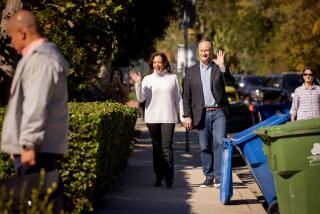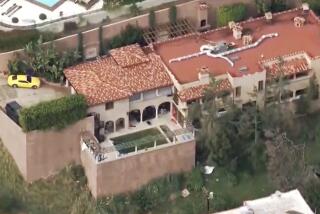Kerry’s Other Home on ‘the Hill’
BOSTON — At Gary’s Drugstore, pharmacist Herman Greenfield keeps a box of keys for neighbors who get locked out of their houses. If children on Beacon Hill don’t get picked up from their school bus stop, they go to Charles Street Supply Co. and Hardware, where owner Jack Gurnon not only watches the kids, but lends them money if they run short.
On Halloween, just about everyone on “the hill” sits on their doorsteps and hands out candy -- even Sen. John F. Kerry and Teresa Heinz Kerry, who became denizens of one of the city’s most sought-after enclaves when they bought a five-story townhouse in 1995.
The Kerrys settled in a neighborhood that former Boston Mayor Kevin White described as “very intimate, and yet it has a certain social panache.”
Sam Shapiro, a retired naval officer who moved to Mount Vernon Street 35 years ago, said he loved the informality of Beacon Hill. “Nobody has to dress up,” he said. “It’s the kind of neighborhood where a lot of people know each other.”
With its cobblestone streets, brick sidewalks and early 19th century row houses, the neighborhood where Nancy Macmillan has lived for 30 years “looks different” from the small Iowa town she grew up in. But, she said, “it feels very much the same.”
The square-mile area directly behind the Massachusetts statehouse prides itself on stability, and so fiercely restricts change that residents must go through an architectural obstacle course to alter so much as the color of their front doors.
“They recently dragged us kicking and screaming into the 20th century,” Greenfield said. “Don’t push us about the 21st.”
But Beacon Hill, home to about 9,500 people, had no choice but to bow to the winds of modernity when Kerry became the presumptive Democratic presidential candidate several months ago. An armada of Secret Service vehicles converged in front of the Kerry home on Louisburg Square -- with its 27 residences, it is Beacon Hill’s most coveted address. That caused consternation among homeowners whose mansions line a private park designed by Charles Bulfinch in 1826.
After an emergency meeting of the Beacon Hill Assn., Secret Service agents agreed to be more respectful about leaving their vehicles’ engines running at all hours. Soon residents were so chummy with the agents that they started bringing them hors d’oeuvres.
Late Sunday night, a set of barriers went up around Louisburg Square, giving access to residents only.
The Schueler-Cox family, visiting from Berkeley, on Monday managed to glimpse the Kerry residence by craning past four Secret Service agents and a bank of Massachusetts state police officers.
“I think it’s really ugly,” said Emma Cox, 14.
“It’s understated, dear,” replied her father, Paul Cox.
Emma’s mother, Margo Schueler, said that the design of the Kerrys’ $12.8-million Federalist-style house -- once a convent for Episcopal nuns -- made her uncomfortable. “Coming from a seismically active zone, these five-story brick buildings terrify us,” she said.
Just around the corner from the Kerry residence, Laurence Lieberman said he had to walk six blocks out of his way to pick up his laundry because Louisburg Square was blocked off. Lieberman, an educational consultant, said he often waves at Kerry as the candidate in-line skates up the steep incline of Beacon Hill, and sees the Kerrys when they walk their dog.
“You just say hello, and they say hello back,” he said. “That’s the way it is here. It’s not snooty, it’s not snobby. It’s like a village.”
On Charles Street, with its antique stores, restaurants and small businesses, tavern owner John Everett Martin said he feels like he knows Kerry because they both slip into the 7-Eleven to buy chocolate chip ice cream.
With the Democratic National Convention gathering just a few blocks from Beacon Hill, Macmillan admitted that this week, “it is a little inconvenient” having a presidential candidate in the neighborhood.
But, she added, “I hope it stays inconvenient for the next eight years.”
More to Read
Get the L.A. Times Politics newsletter
Deeply reported insights into legislation, politics and policy from Sacramento, Washington and beyond. In your inbox three times per week.
You may occasionally receive promotional content from the Los Angeles Times.










